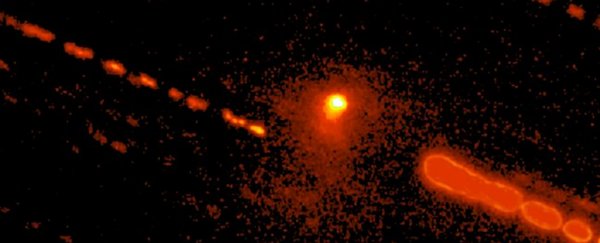Centaurs are rare celestial objects that can combine some of the different features of asteroids and comets. They're basically rocky in nature, like asteroids, but can also throw out clouds of dust and gas as their exteriors vaporize, like comets.
When centaurs emit these gases, they're considered active. We've only ever found 18 chemically active centaurs in the last century or so, but now a new one has been added to the list – and it might be able to tell us more about how these mysterious flying rocks develop their unique characteristics.
Keeping a close eye on centaurs is a huge challenge – they're a long way away, orbit in irregular ways, and take up a lot of telescope time – but in this case, researchers studied archival images as well as used new data gathered from the Dark Energy Camera at the Inter-American Observatory and the Walter Baade Telescope at the Las Campanas Observatory, both in Chile, and the Large Monolithic Imager at Lowell Observatory's Discovery Channel Telescope in Arizona.
"We developed a novel technique that combines observational measurements – for example, colour, and dust mass – with modeling efforts to estimate such characteristics as the object's volatile sublimation and orbital dynamics," says astronomer Colin Chandler, from the Northern Arizona University.
That technique, involving a specially developed algorithm to look for activity traces in existing space imagery, revealed evidence of Centaur 2014 OG392 converting solids into gases (sublimation) and leaving behind a long comet-like halo.
Backed up with new observations recorded over the course of the past two years, it seems clear that this particular centaur is special. Computer modelling then helped the astronomers figure out what types of ice could be burning off the rock.
It's a tricky calculation to make, not least because the asteroid is probably not made from one type of ice but from a mix of materials that can all burn differently. The researchers think they know what's happening, however, and what might be happening on other similar objects.
"We detected a coma as far as 400,000 km [248,548 miles] from 2014 OG392," says Chandler, "and our analysis of sublimation processes and dynamical lifetime suggest carbon dioxide and/or ammonia are the most likely candidates for causing activity on this and other active centaurs."
A coma is an envelope of ice and comet dust that forms around the comet's nucleus as it passes close to the Sun. It is the coma that gives comets their fuzzy appearance.
Because of the discovery, the centaur is no longer a centaur any more – it's a fully-fledged comet, with the designation C/2014 OG392 (PANSTARRS), something that the researchers are "very excited" about.
These types of objects, and others like them, are thought to have barely changed since the very early days of the Solar System, and that means they're incredibly useful time capsules for studying how our planets formed and settled into their own orbits.
Any centaurs, comets, and asteroids that are still around are still around for a reason – they haven't spun out of the Solar System or flown into the Sun – and scientists can work backwards from that.
There's lots more to discover about centaurs, and we're learning more about how they work all the time. As more data is gathered and better analysis techniques are developed, we should finally be able to solve some of the mysteries surrounding these weird and wonderful Solar System travellers.
The research has been published in Astrophysical Journal Letters.
